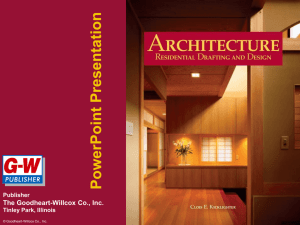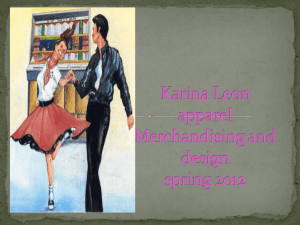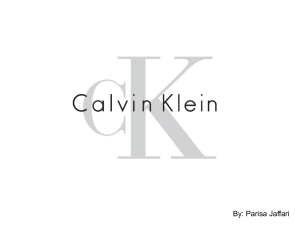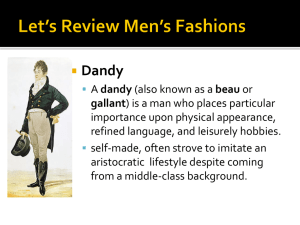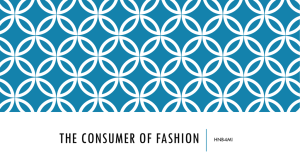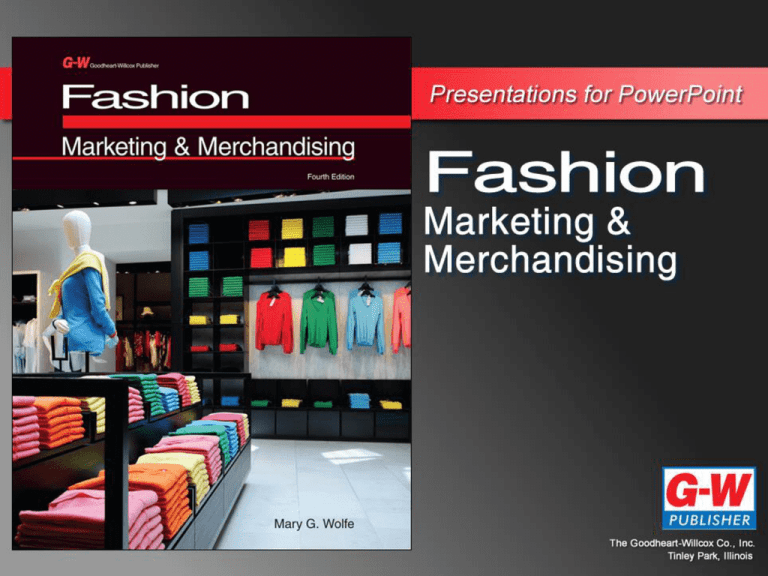
Special Event Fashion
Shows
Objectives
• Explain the many purposes of fashion
shows.
• List the main types of fashion shows.
• Identify the different aspects of planning
for fashion shows.
• Discuss the coordination of merchandise
and models for the final lineup of fashion
shows.
continued
© Goodheart-Willcox Co., Inc.
Permission granted to reproduce for educational use only.
Objectives
• Summarize the coordination of the physical
layout, music, choreography, and
commentary of fashion shows.
• Explain the aspects of promoting and
presenting a smooth fashion show
performance.
• Describe the follow-up and evaluation
procedures for fashion shows.
© Goodheart-Willcox Co., Inc.
Permission granted to reproduce for educational use only.
Special Events
• Special events are promotional activities
held to build customer traffic, sell goods, and
enhance the company image
– They help distinguish a company from
competitors
• Fashion shows are some of the most exciting
special events for those involved in the
fashion industry
© Goodheart-Willcox Co., Inc.
Permission granted to reproduce for educational use only.
Fashion Insights
• Fashion shows are theatrical
presentations of apparel and accessories
on live models
• They occur at the beginning of fashion
seasons to introduce new merchandise
• The shows occur at several market
levels
– Consumer fashion shows are presented by
retailers to consumers
© Goodheart-Willcox Co., Inc.
Permission granted to reproduce for educational use only.
Fashion Shows Serve Many
Purposes
– A fashion show for retail promotion makes a
visual statement that helps sell merchandise
– Promotional fashion shows for business programs
and social luncheons include various designers,
manufacturers, or retailers
– Cooperative fashion shows are jointly sponsored
by two or more organizations
– In-store training shows and student fashion
shows are also popular
© Goodheart-Willcox Co., Inc.
Permission granted to reproduce for educational use only.
Types of Fashion Shows
• Shows can be extravaganzas or small events
• The most elaborate and expensive is the
production fashion show
– It includes backdrops, lighting effects, and
entertainment with choreography
• Choreography is the planned arrangement
of movement, such as specific dance steps or
gestures
continued
© Goodheart-Willcox Co., Inc.
Permission granted to reproduce for educational use only.
Types of Fashion Shows
• The formal runway show is a typical
presentation of fashion models parading on a
runway in a certain order of appearance
– The merchandise and staging follows a theme
– It has special lighting, music, and commentary
– It requires much organization and planning
continued
© Goodheart-Willcox Co., Inc.
Permission granted to reproduce for educational use only.
Types of Fashion Shows
• Commentary is a spoken message about
specific features of each outfit modeled
• An informal fashion show is a casual
presentation of garments and accessories
• Tearoom modeling is an informal show
– Models walk from table to table in a restaurant to
show and describe what they are wearing
© Goodheart-Willcox Co., Inc.
Permission granted to reproduce for educational use only.
Planning Fashion Shows
• Major advance planning decisions must be
made about the audience, theme, time and
location, and safety and security
– The budget must be carefully planned, with
allocations for each type of expense
• Advance planning of fashion shows enables
the final presentation to run smoothly and
professionally
© Goodheart-Willcox Co., Inc.
Permission granted to reproduce for educational use only.
The Fashion Show Coordinator
• A fashion show coordinator is in charge
of the entire presentation
– The coordinator plans all arrangements,
delegates responsibilities, and is accountable for
all details
• The fashion show coordinator and committee
chairpersons continually review the progress
of the plans
© Goodheart-Willcox Co., Inc.
Permission granted to reproduce for educational use only.
Pinpointing the Audience
• Pinpointing the target market of the fashion
show impacts all other decisions
• A guaranteed audience is established
before the show is organized and will attend
regardless of the show details
– Example: A fashion show at a business luncheon
is seen by those who would have attended even
if no show were held
continued
© Goodheart-Willcox Co., Inc.
Permission granted to reproduce for educational use only.
Pinpointing the Audience
• A created audience is established after the
show is planned as a result of publicity and
advertising
– A created audience wants to see the new fashion
trends and attend a social event
• The age of the audience influences the
choice of music and entertainment to be
included
© Goodheart-Willcox Co., Inc.
Permission granted to reproduce for educational use only.
Deciding on the Theme
• The theme of a fashion show is developed
for
– the target audience
– a holiday or time of year
– the merchandise to be featured
• A title is chosen indicating the show’s content
• The theme and title are used to guide all
planning steps
© Goodheart-Willcox Co., Inc.
Permission granted to reproduce for educational use only.
Timing and Location for the
Show
• Models, show workers, and the audience
should be considered when selecting the
show time
• Consumer fashion shows may last about 30
to 45 minutes for the fashion segment
• The location of the fashion show is
coordinated with where the audience is and
the show’s purpose, type, and size
continued
© Goodheart-Willcox Co., Inc.
Permission granted to reproduce for educational use only.
Timing and Location for the
Show
• The date and place are booked after making
sure the location will meet all show needs
• If informal modeling occurs at a restaurant, a
contract is probably not required
• If the fashion show is held for customers in a
store, a large room can be set up for the
show
© Goodheart-Willcox Co., Inc.
Permission granted to reproduce for educational use only.
Safety and Security
Considerations
• The safety and security of merchandise,
equipment, show participants, and the
audience must be considered
– Merchandise used must be protected from
wearing damage, as well as from theft
– Security personnel may have to be hired to
prevent theft or vandalism
• It is wise to buy insurance that covers all
aspects of the show
© Goodheart-Willcox Co., Inc.
Permission granted to reproduce for educational use only.
Budget Planning
• The first step in planning a fashion show
budget is to forecast expected revenues for
the show
• Fashion show expenditures are divided
among the different committees, according
to estimated needs
• There is no site rental cost if the fashion
show is held in the manufacturer’s showroom
or at a retail store
continued
© Goodheart-Willcox Co., Inc.
Permission granted to reproduce for educational use only.
Budget Planning
• When space is rented, the season, day, and
time all affect the price
• Fees for professional models are paid on an
hourly or daily basis
• Expenses for promotion include publicity and
advertising preparation and media costs
• The budget must include wages for people
hired to build sets and do technical work
© Goodheart-Willcox Co., Inc.
Permission granted to reproduce for educational use only.
Coordinating Merchandise and
Models
• Merchandise and models must be
coordinated with each other
– They must also be coordinated with the fashion
show theme and the type of audience
• This coordination involves
– merchandise selection
– model selection
– fittings and lineup
© Goodheart-Willcox Co., Inc.
Permission granted to reproduce for educational use only.
Merchandise Selection
• Merchandise selection involves choosing the
best garments, shoes, and accessories for
the show
• The merchandise must
– represent the latest trends
– match the age, sex, lifestyle, and spending habits
of the audience
• Five to eight merchandise categories are
usually included in a show
continued
© Goodheart-Willcox Co., Inc.
Permission granted to reproduce for educational use only.
Fashion Insights
• Three-quarters of the merchandise in
fashion shows should be items the
audience will buy and wear
• Merchandise categories usually build
from the most casual to the most
dramatic
• The number of outfits to be shown is
paced at one or two per minute
© Goodheart-Willcox Co., Inc.
Permission granted to reproduce for educational use only.
Merchandise Selection
• Before merchandise is actually selected, an
ideal chart lists all categories to be
presented and the number of garments
planned per category
– A merchandise pull is the removing of show
items from the sales floor to a storage area
– A merchandise loan record gives details of the
merchandise borrowed from retailers
© Goodheart-Willcox Co., Inc.
Permission granted to reproduce for educational use only.
Model Selection
• Fashion should be able to promote outfits to
the audience by presenting them in a
believable way
• Fashion show models must be attractive and
well-groomed, with good hair and skin
• Professional models have training and
experience and are hired through modeling
agencies
continued
© Goodheart-Willcox Co., Inc.
Permission granted to reproduce for educational use only.
Model Selection
• Amateur models are not trained or
represented by agencies
• The fashion show budget determines
whether professional or amateur models are
used
• Untrained models must be coached about
walking, timing, posing, turning, and facial
expressions
continued
© Goodheart-Willcox Co., Inc.
Permission granted to reproduce for educational use only.
Model Selection
• More models may be needed since untrained
models take longer to change their outfits
• After all models are selected for the show, a
model list is prepared
– It includes names, telephone numbers, and
apparel sizes for the models
• Notes on the models used should be filed
© Goodheart-Willcox Co., Inc.
Permission granted to reproduce for educational use only.
The Fittings and Lineup
• The model order is the rotation of models in
the show
• The lineup is the order in which outfits will
appear in the show
• The model order is finalized from the fittings
and rehearsals
• Fittings are when the models try on the
merchandise to see how the garments fit
continued
© Goodheart-Willcox Co., Inc.
Permission granted to reproduce for educational use only.
The Fittings and Lineup
• One fitting sheet is prepared per lineup
number
• Finally, the garments and accessories are
covered with plastic bags, packed, and
transferred to the show location
• Individual model lineup sheets help models
clarify their order of appearance, outfits, and
other details
© Goodheart-Willcox Co., Inc.
Permission granted to reproduce for educational use only.
The Physical Layout
• The physical layout, music, choreography,
and commentary for the show must work
together
• The stage is the background where models
enter and exit within the view of the
audience
– Formal shows require staging
• Runways are elevated walkways that
project out from the stage
continued
© Goodheart-Willcox Co., Inc.
Permission granted to reproduce for educational use only.
The Physical Layout
• The location and distance between the
dressing area and runway are important
• More models are needed if it takes a long
time to get to and from the dressing area
• The dressing area should be big enough for
the amount of models, helpers, and
merchandise being used
continued
© Goodheart-Willcox Co., Inc.
Permission granted to reproduce for educational use only.
The Physical Layout
• Seating arrangements must let the audience
see the show from every location without
obstacles
• The stage background should have an open
and subdued feeling, enhancing the theme
and clothing
• Props can be carried by the models or placed
on the stage
© Goodheart-Willcox Co., Inc.
Permission granted to reproduce for educational use only.
The Music
• Music can be live or taped, instrumental or
vocal
– It must relate to the age and tastes of the
audience
• Live music is expensive, so pre-recorded
music or a small musical group may be
chosen
• Permission may need to be obtained for
using copyrighted music
continued
© Goodheart-Willcox Co., Inc.
Permission granted to reproduce for educational use only.
The Music
• The music mix combines different music
selections to create specific moods
• Music for the show should include a variety
that matches the merchandise categories and
commentary
• A music planning sheet is used to list the
different selections per merchandise item
© Goodheart-Willcox Co., Inc.
Permission granted to reproduce for educational use only.
The Choreography
• Choreography is used to plan the models’
walking or dancing and the interaction of
models on the stage and runway
• The consistent pace should be fast enough to
provide interest
• Amateur models sometimes walk too fast or
too slow, which should be addressed during
the rehearsal
continued
© Goodheart-Willcox Co., Inc.
Permission granted to reproduce for educational use only.
The Choreography
• Pivots and pauses are planned and rehearsed
for specific times and places on the stage
– Pivots are turns that are most often done at the
halfway point and end of the runway
• The finale should create excitement
– All models return to the stage and runway
wearing their last and most spectacular outfits
© Goodheart-Willcox Co., Inc.
Permission granted to reproduce for educational use only.
The Commentary
• The commentary describes the garments and
accessories, especially those details that
might be overlooked
• The commentator, or show narrator, should
be a fashion expert who interprets trends for
the audience
• Full commentaries have a script with every
word written that will be said
continued
© Goodheart-Willcox Co., Inc.
Permission granted to reproduce for educational use only.
The Commentary
• Partial commentaries list the major details of
garments in outline form or short sections of
script
– Manufacturers’ fashion shows for prospective
retail buyers do not have spoken commentary
– Consumer runway shows usually use informative
commentary
© Goodheart-Willcox Co., Inc.
Permission granted to reproduce for educational use only.
Promoting and Presenting the
Show
• Free publicity should be emphasized, with
paid advertising used if the budget permits
• Press releases should be sent to all
newspapers and magazines
• Press releases should arrive at the media two
to four weeks before the event
continued
© Goodheart-Willcox Co., Inc.
Permission granted to reproduce for educational use only.
Promoting and Presenting the
Show
• Media space can be purchased for newspaper
advertisements
– The draft of a print advertisement is called a
pasteup
• Radio commercials can be effective if a
station matches the show’s target audience
• A retailer may place local magazine and TV
spot ads if they are not too expensive
continued
© Goodheart-Willcox Co., Inc.
Permission granted to reproduce for educational use only.
Promoting and Presenting the
Show
• Other fashion show promotion can be done
with signs or posters or by mailing flyers or
invitations
• Retailers should inform all salespeople far in
advance of the show so they can promote it
• A school or civic group could spread
information to others about the show
© Goodheart-Willcox Co., Inc.
Permission granted to reproduce for educational use only.
Invitations, Tickets, and
Programs
• The promotion committee handles the design
and printing of invitations, tickets, and
programs
• The program serves as a guide to the
merchandise for the audience
– Its design should reflect the show’s theme
• Sometimes advertising is sold and placed in
programs
© Goodheart-Willcox Co., Inc.
Permission granted to reproduce for educational use only.
Rehearsals and Show Time
• Rehearsals are practice sessions
– Some rehearsals are just run-throughs to work
on choreography
• The full dress rehearsal is a practice of the
finished show, without an audience
• When show time arrives, models should
arrive half an hour to one hour before the
scheduled start of the show
continued
© Goodheart-Willcox Co., Inc.
Permission granted to reproduce for educational use only.
Rehearsals and Show Time
• Models should check that garments and
accessories in their changing area are correct
and arranged in order of appearance
– Dressers help the models change and care for
the clothes
• After doing a last-minute check of model’s
outfit and hair, starters cue the models onto
the stage in the correct order
continued
© Goodheart-Willcox Co., Inc.
Permission granted to reproduce for educational use only.
Rehearsals and Show Time
• The show should start on time
• During the show, models must stay poised
and cover up mistakes or unexpected events
• The finale of the show is a parade of all the
models, with applause all around
• If planning has been thorough, the fashion
show will be a success
© Goodheart-Willcox Co., Inc.
Permission granted to reproduce for educational use only.
Follow-Up and Evaluation
• The set may need to be disassembled and
props and equipment stored
• Garments and accessories should be returned
to retailers, with items being clean and
pressed
• Thank-you notes should be sent to those
who helped in some way
• The last important task is an evaluation of
the show by all persons involved
© Goodheart-Willcox Co., Inc.
Permission granted to reproduce for educational use only.
In Summary
• Special events provide promotion through
celebrity visits, contests, and fashion
shows
• Fashion shows are popular special events
• Advance planning and communication of
job assignments is important for
presentations
• Merchandise and model selection must be
coordinated
continued
© Goodheart-Willcox Co., Inc.
Permission granted to reproduce for educational use only.
In Summary
• Stage decorations, backdrops, runways,
lighting, and props need to be
considered
• Fashion shows are promoted with
publicity and advertising
• Rehearsals are held to practice all
aspects of the show
• An evaluation of the show helps to make
future shows even better
© Goodheart-Willcox Co., Inc.
Permission granted to reproduce for educational use only.

